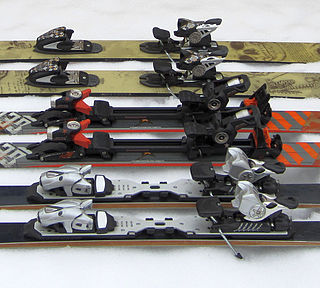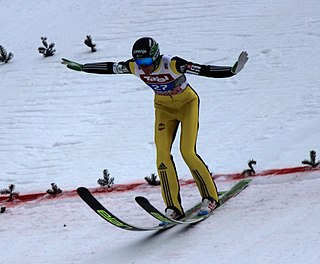
A kick is a physical strike using the leg, in unison usually with an area of the knee or lower using the foot, heel, tibia (shin), ball of the foot, blade of the foot, toes or knee. This type of attack is used frequently by hooved animals as well as humans in the context of stand-up fighting. Kicks play a significant role in many forms of martial arts, such as capoeira, kalaripayattu, karate, kickboxing, kung fu, MMA, Muay Thai, pankration, pradal serey, savate, sikaran, silat, taekwondo, vovinam, and Yaw-Yan. Kicks are a universal act of aggression among humans.

Running is a method of terrestrial locomotion by which humans and other animals move rapidly on foot. Running is a gait with an aerial phase in which all feet are above the ground. This is in contrast to walking, where one foot is always in contact with the ground, the legs are kept mostly straight, and the center of gravity vaults over the stance leg or legs in an inverted pendulum fashion. A feature of a running body from the viewpoint of spring-mass mechanics is that changes in kinetic and potential energy within a stride co-occur, with energy storage accomplished by springy tendons and passive muscle elasticity. The term "running" can refer to a variety of speeds ranging from jogging to sprinting.

Telemark skiing is a skiing technique that combines elements of Alpine and Nordic skiing, using the rear foot to keep balance while pushing on the front foot to create a carving turn on downhill skis with toe-only bindings. Telemark skiing is named after the Telemark region of Norway, where the discipline originated. Sondre Norheim is often credited for first demonstrating the turn in ski races, which included cross country, slalom, and jumping, in Norway around 1868. Sondre Norheim also experimented with ski and binding design, introducing side cuts to skis and heel bindings.

A ski binding is a device that connects a ski boot to the ski. Before the 1933 invention of ski lifts, skiers went uphill and down and cross-country on the same gear. As ski lifts became more prevalent, skis—and their bindings—became increasingly specialized, differentiated between alpine (downhill) and Nordic styles of skiing. Until the point of divergence in the mid-20th century, bindings held the toe of a flexible, leather boot against the ski and allowed the heel to rise off the ski, typically with a form of strap or cable around the heel.
The parallel turn in alpine skiing is a method for turning which rolls the ski onto one edge, allowing it to bend into an arc. Thus bent, the ski follows the turn without sliding. It contrasts with earlier techniques such as the stem Christie, which slides the ski outward from the body ("stemming") to generate sideways force. Parallel turns generate much less friction and are more efficient both in maintaining speed and minimizing skier effort.
Ski boots are footwear used in skiing to provide a way to attach the skier to skis using ski bindings. The ski/boot/binding combination is used to effectively transmit control inputs from the skier's legs to the snow.
Because ballet became formalized in France, a significant part of ballet terminology is in the French language.

A squat is a strength exercise in which the trainee lowers their hips from a standing position and then stands back up. During the descent, the hip and knee joints flex while the ankle joint dorsiflexes; conversely the hip and knee joints extend and the ankle joint plantarflexes when standing up. Squats also help the hip muscles.
Dance position is a position of a dancer or a mutual position of a dance couple assumed during a dance. Describing and mastering proper dance positions is an important part of dance technique.

The front kick in martial arts is a kick executed by lifting the knee straight forward, while keeping the foot and shin either hanging freely or pulled to the hip, and then straightening the leg in front of the practitioner and striking the target area. It is desirable to retract the leg immediately after delivering the kick, to avoid the opponent trying to grapple the leg and to return to stable fighting stance.
Glide step is a form of movement used by marching bands to minimize upper body movement, enabling musicians to play their instruments and march without air-stream interruptions. Standardizing the style of marching also serves to add to the visual effect of a marching band. Sometimes special shoes are worn with a curved heel that facilitates rolling the foot. Glide stepping is used by many high school marching bands, college marching bands, and by many Drum Corps. Glide stepping is sometimes also known as "roll stepping".
Karate has many different stances, each used for different types of power and movement. In Japanese the general term is Tachi (立ち) changing to dachi when used as a suffix. Some stances focus more on mobility than stability, and vice versa.
The following is a glossary of figure skating terms, sorted alphabetically.
Stances are a highly fundamental part of all Chinese Martial Arts. Wushu is characterized by low, wide stances designed for mobility and protection. Stability is another key concern of Chinese martial arts, and the wushu stances reflect this sensibility. There are five key stances utilized in both contemporary wushu and traditional wushu. Many others exist, and different styles of wushu prescribe a particular protocol for "correct" stance.
This is a general glossary of the terms used in the sport of gymnastics.

Añjaneyāsana, Crescent Moon Pose, or Ashva Sanchalanasana is a lunging back bending asana in modern yoga as exercise.
This glossary of skiing and snowboarding terms is a list of definitions of terms and jargon used in skiing, snowboarding, and related winter sports.

The Haferl landing also called parallel landing, is a landing technique in ski jumping. To perform this landing, the athlete slightly parts their legs, bends both knees and aligns the fronts of the skis in the landing process.








